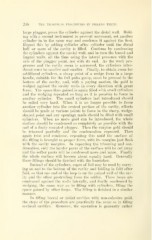Page 524 - My FlipBook
P. 524
248 THE TECHNICAL, PROCEDURES IN FILLING TEETH.
large plugger, press the cylinder against the distal wall. Hold-
ing with a second instrument to prevent movement, set another
cylinder in in the same way and condense it against the first.
Eepeat this by adding cylinder after cylinder until the distal
half or more of the cavity is filled. Continue by condensing
the cylinders against the mesial wall, and in turn the buccal and
lingual walls, all the time using the lateral pressure with the
side of the plugger point, not with its end. As the work pro-
gresses and the cavity room is narrowed, the cylinders intro-
duced must be smaller and smaller. Finally, to obtain room for
additional cylinders, a sharp point of a wedge form in a large
handle, suitable for the full palm grasp, must be pressed to the
bottom of the cavity, and, with a prying motion, the gold is
wedged against the cavity walls in every direction with great
force. The space thus gained is again filled with small cylinders
and the wedging repeated so long as it is possible to force in
another cylinder. The small cylinders last introduced should
be rolled very hard. When it is no longer possible to force
another cylinder into the central portion of the cavity, efforts
should be made at various points to force in the sharp, wedge-
shaped point and any openings made should be filled with small
cylinders. Wlien no more gold can be introduced, the whole
surface should be condensed as completely as possible with the
end of a finely serrated plugger. Then the surplus gold should
be trimmed partially and the condensation repeated. Then
again trim and condense, repeating this until the surface of
the filling is brought to proper form, with its margins just flush
with the cavity margins. In repeating the trimming and con-
densation, only the harder parts of the surface will be cut away
and the softer parts will be condensed more and more. Finally
the whole surface will become about ecjually hard. Generally
these fillings should be finished with the burnisher.
Instead of the cylinders, ropes of foil may be used by carry-
ing an end to tlie bottom of the cavity and folding in fold after
fold, so that one end of the loop is on the pulpal wall of the cav-
ity and the other protruding from the orifice. These loops are
condensed against the walls laterally, and finally condensed by
wedging, the same way as in filling with cylinders, filling the
space gained by other loops. The filling is finished in a similar
manner.
In filling buccal or hibial cavities with non-cohesive gold,
the steps of the procedure are practically the same as in filling
occlusal cavities. However, the operation is generally rather


